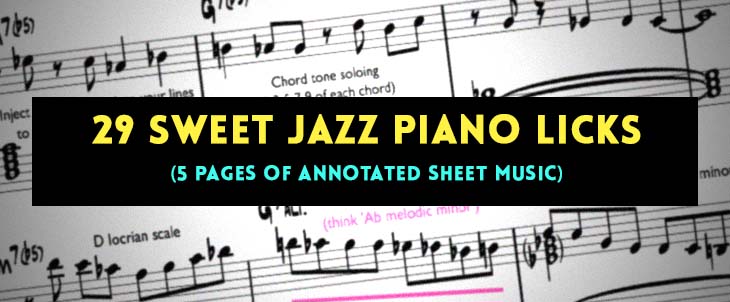Learn these 4 Dominant 7 Scales for Jazz Piano
There are 4 main Jazz scales that you can play over a dominant 7 chord:
- Lydian-dominant scale
- Whole tone scale
- Diminished scale
- Altered scale
Which one you use depends on two things:
- The context (whether you're in a major 2-5-1, or a minor 2-5-1).
- Personal preference (each player has their favorite scales and voicings, etc).
Here's what you need to know about each scale.
Why focus on the dominant 7 chord instead of the major 7 or minor 7 chord?
Most of jazz is built on 2-5-1 chord progressions.
A 2-5-1 in C major would be D minor 7, G dominant 7, ending on C major 7.
The scale you could play over all three of these chords would be C major, since it’s a 2-5-1 in C major, and all three chords are taken from C major.
This sounds fine and consonant, which a beginner jazz musician might play by using the scale of the one chord over all three chords.
However, this doesn’t sound very sophisticated.
To create a sophisticated sound in jazz, you want to change the scale with each new chord, essentially changing key.
Free Resource: Download my '29 Jazz Piano Licks' sheet music.
Looking at the 2-5-1, we’ve got three chords each implying the same scale.
To change the scale, the most efficient way isn’t to change all three scales but to stick to the C major scale for the two chord and the one chord (the first and last chord).
Then, change things up for the middle chord, the five chord.
By making the five chord change key, we achieve a sophisticated sound, going from C major to an exotic dominant 7 scale and back to C major.
The Lydian Dominant Scale:
First up is the Lydian dominant scale. I’ll start with C because learning new scales starting from the same note is effective.
The Lydian dominant scale is the dominant scale, also known as the Mixolydian mode, but with a sharp four.
Applying this scale to our 2-5-1 in C major: over D minor 7, we play C major.
Over G dominant 7, we play the G Lydian dominant scale, then back to C major for the final chord.
When playing a solo over a 2-5-1 and changing the dominant 7 scale, aim for the changing notes, ensuring the scale change is noticeable.
IMAGE
The Whole Tone Scale:
Next is the whole tone scale, which is a series of whole tones, resulting in a six-note scale with a dreamy sound often used in films. It fits well in jazz, especially over the dominant 7 scale.
You’ll need to re-harmonize the five chord to go from just C7 to C7 sharp 5.
Applying this to our 2-5-1 in C major means playing the G whole tone scale over the G7 chord.
Aim for the changing notes, particularly the sharp four and sharp five. The whole tone scale comprises two augmented chords, allowing for interesting patterns.
IMAGE
Free Resource: Download my 'Chord Symbol Reference Guide'
Shows you all types of Jazz chord notated clearly on one page - including 7ths, 9ths, 11ths, 13ths.
The Diminished Scale:
The diminished scale is next. It’s a repeating pattern of half step, whole step, and can be played over several types of chords but is most often used over the dominant 7 chord.
Applying this to our 2-5-1 in C major means playing the G diminished scale over the G7 chord, aiming to use its distinct notes in the solo.
IMAGE
The Altered Scale:
Finally, we have the altered scale, the most complex dominant 7 scale. Over C dominant 7, you can play the C altered scale.
It’s called the altered scale because it includes every altered note possible apart from the root, third, and seventh.
This involves a flat nine, sharp nine, sharp 11, and flat 13.
Thinking of this scale as D flat melodic minor simplifies it:
Build a melodic minor scale off of the flat second of the dominant chord.
Applying this to our 2-5-1 in C major means playing the G altered scale over the G7 chord, aiming to create sophistication with minimal effort.
IMAGE
Free Resource: Download my '30 Beginner Jazz Songs' list.
Conclusion:
In this article, we discussed different kinds jazz scales including the four exotic dominant 7 scales: Lydian dominant, whole tone, diminished, and altered scales.
Key Takeaways
-
In jazz, 2-5-1 chord progressions are common, and using the same scale for all three chords can sound basic; changing the scale with each chord adds sophistication.
-
The Lydian dominant scale, with a sharp four, is used over the five chord in a 2-5-1 progression.
-
The whole tone scale, characterized by whole steps, fits well over a dominant 7 chord and requires re-harmonizing the five chord.
-
The altered scale, which includes multiple altered notes, can be simplified by thinking of it as the melodic minor scale built off the flat second of the dominant chord.
Recommended Lesson
'Jazz Improvisation Explained in 18 Minutes'
These are the most-used improvisation techniques that you need to know about:
Free Resource: Download my '29 Jazz Piano Licks' sheet music.
What's Popular Now
'29 Jazz Piano Licks' sheet music

'Chord Voicing Guide for Jazz Piano'
This 11-page guide shows you chord voicings that professional Jazz pianists use.
6 pages of sheet music. Shares my top chord progressions and chord voicings.
One page cheat sheet. Shows you all common Jazz chords notated clearly:
